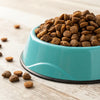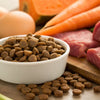Can You Feed Your Dog Raw and Kibble? A Comprehensive Guide
- Houndsy
Table of Contents
- Introduction
- Understanding Raw and Kibble Diets
- Benefits of Mixing Raw and Kibble
- Debunking Myths Around Mixing Raw and Kibble
- How to Safely Mix Raw and Kibble
- Practical Tips for Feeding Raw and Kibble
- Conclusion
- FAQ Section
Introduction
As dog owners, we all want the best for our furry friends. Did you know that nearly 40% of pet parents are exploring alternative diets for their dogs, including the blending of raw and kibble? This trend sparks curiosity and sometimes confusion about the safety and efficacy of mixing these two types of dog food. Many of us harbor questions: Can you feed your dog raw and kibble together? Is it safe? What are the potential benefits and risks involved?
In this blog post, we will delve into the nuances of combining raw and kibble dog food, exploring the science behind digestion, the myths surrounding this practice, and practical tips for implementation. By the end of this article, you will have a comprehensive understanding of whether you can mix raw food with kibble and how to do it effectively for your pet's health and happiness.
Let’s embark on this journey together, reflecting on our own pet feeding routines and considering how we can optimize them for our beloved companions.
Understanding Raw and Kibble Diets
The Basics of Dog Nutrition
Dog nutrition can be a complex topic, as it encompasses a range of diets designed to meet the dietary needs of our canine companions. The two primary types of dog food are raw food and kibble.
- Raw Food Diet: This consists of uncooked meat, bones, fruits, and vegetables. Proponents argue that raw diets provide essential nutrients, enhance digestion, and improve coat condition.
- Kibble: This is commercially prepared dry dog food that is cooked and processed. Kibble is convenient and often fortified with vitamins and minerals, making it a popular choice among pet owners.
Both diets have their merits, and understanding their differences is crucial if you are considering mixing them.
Nutritional Composition
- Raw Food: Typically high in protein, raw diets are rich in moisture and lower in carbohydrates. This combination can lead to improved digestion and energy levels in some dogs.
- Kibble: While convenient, kibble can vary widely in nutritional quality. It usually contains more carbohydrates and less moisture. Some kibble brands may include fillers and artificial ingredients, which can detract from their nutritional value.
Digestive Capabilities of Dogs
A dog's digestive system is quite resilient. Dogs are omnivores, evolved to consume a variety of foods. Their stomachs produce strong acids that can effectively break down both raw and processed foods. However, the transition between different diets should be carefully managed to avoid gastrointestinal upset.
Benefits of Mixing Raw and Kibble
Enhanced Nutrition
One of the primary advantages of mixing raw and kibble is the potential for a more balanced diet. By combining the two, you can harness the benefits of both worlds:
- Variety: Dogs thrive on variety. Mixing raw and kibble can prevent mealtime monotony and stimulate their appetites.
- Nutrient Boost: Adding raw meats, bones, or even fresh vegetables to kibble can enhance its nutritional profile.
Cost-Effectiveness
For many pet owners, raw diets can be expensive. Mixing kibble with raw food can help balance the costs while still providing your pet with quality nutrition. For instance, you could consider a 50/50 ratio, allowing you to stretch your budget while incorporating valuable raw nutrients.
Improved Digestive Health
While some believe mixing raw and kibble can lead to digestive issues, the reality is that many dogs adapt well to both food types. The key is to introduce changes gradually. By doing so, you can promote a healthy gut microbiome and potentially reduce issues like allergies and skin irritations.
Debunking Myths Around Mixing Raw and Kibble
Myth 1: Raw and Kibble Are Too Different to Digest Together
Many dog owners fear that mixing raw and kibble will confuse their dog's digestive system. The truth is, dogs can digest a variety of food types effectively. Once consumed, the digestive system breaks down food into its basic components—water, protein, fats, and carbohydrates—regardless of the source.
Myth 2: Mixing Causes Upset Stomach
The belief that mixing raw and kibble causes gastrointestinal distress is often rooted in anecdotal evidence. In reality, digestive upset is usually a result of sudden diet changes rather than the combination itself. Gradual transitions allow dogs to adapt without issues.
Myth 3: It Encourages Bad Bacteria Growth
Another misconception is that mixing raw food with kibble can foster harmful bacteria in the gut. Dogs naturally harbor diverse gut bacteria, and their systems are well-equipped to manage different food types. As long as you maintain proper hygiene when handling raw food, the risks are minimal.
How to Safely Mix Raw and Kibble
Gradual Introduction
If you're considering introducing raw food into your dog's kibble diet, start slowly. Gradually increase the percentage of raw food over 4-6 days. For example, start with an 80/20 split (80% kibble and 20% raw) and adjust based on your dog's tolerance.
Recommended Ratios
While the ideal ratio can vary based on your dog's individual needs, here are a few general guidelines to consider:
- 50/50 Split: Ideal for dogs transitioning from a kibble-only diet to a mixed diet.
- 70/30 Split: A good option for dogs who need more raw nutrients without fully transitioning.
- 80/20 Split: Suitable for pet owners who prefer kibble as a primary food but want to supplement with raw.
Meal Timing
You can also choose to feed raw and kibble at different times of the day. For example, serve kibble in the morning and raw in the evening. This method can simplify digestion, especially for dogs with sensitive stomachs.
Practical Tips for Feeding Raw and Kibble
Use Raw as a Topper
One effective method for mixing raw and kibble is to use raw food as a topper. This way, you can enhance the flavor and nutritional content of kibble without changing the entire meal format. Adding a spoonful of raw meat or some fresh vegetables can make mealtime more enticing.
Incorporate Boosters
Consider adding nutrient boosters to your dog's kibble, such as:
- Bone Broth: Soaking kibble in bone broth can enhance flavor and nutrition.
- Canned Fish: Options like sardines (in water, not oil) can provide omega-3 fatty acids.
- Eggs: A raw egg is an excellent protein source and can boost overall nutrition.
Monitor Your Dog’s Response
As you implement changes, keep an eye on your dog's health and behavior. Look for signs of digestive distress, changes in energy levels, or skin issues. Adjust the diet as needed and consult your veterinarian for guidance.
Conclusion
Mixing raw and kibble is not only possible but can also be beneficial for your dog if done thoughtfully. By understanding the nutritional aspects, debunking common myths, and following practical guidelines, we can enhance our pets' diets while enjoying the convenience of kibble. Remember, every dog is unique, so take the time to observe how your furry friend responds to any dietary changes.
If you're seeking a convenient way to elevate your dog’s feeding experience, consider exploring the Houndsy Kibble Dispenser. With its sleek design and perfect portion control, it can simplify your dog feeding routine while adding an elegant touch to your home. Order Now and transform mealtime into a delightful experience for both you and your pet.
FAQ Section
Can I feed my dog raw and kibble together?
Yes, dogs can safely digest a combination of raw and kibble as long as the transition is gradual.
What ratio of raw to kibble should I use?
A common starting point is a 50/50 ratio, but you can adjust based on your dog's preferences and dietary needs.
Will mixing raw and kibble cause digestive problems?
Not typically. Digestive issues usually arise from sudden diet changes, not from blending raw and kibble.
How can I introduce raw food into my dog's diet?
Start with a small percentage of raw food and gradually increase it over several days to allow your dog's digestive system to adapt.
What if my dog has a sensitive stomach?
If your dog is sensitive, consider feeding raw and kibble at different times or consult your veterinarian for tailored advice.
By understanding the benefits and best practices of mixing raw and kibble, we can create a more balanced and enjoyable feeding experience for our pets.












